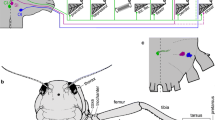Summary
A discrete middle band of tonic fibers in the claw closer muscles of lobsters functions as a sub-unit of the slow motor unit in maintaining dactyl posture at a low frequency of firing due to its synaptic properties and strategic location.
Similar content being viewed by others
References
C. A. G. Wiersma, in: The Physiology of Crustacea, vol. 2, p. 191. Ed. T. H. Waterman. Academic Press, New York 1961.
H. L. Atwood, Prog. Neurobiol.7, 291 (1976).
C. A. G. Wiersma, Archs néerl. Zool.11, 1 (1955).
C. K. Govind and F. Lang, J. exp. Zool.190, 281 (1974).
W. J. Costello and F. Lang, Biol. Bull.156, 179 (1979).
W. J. Costello, R. Hill and F. Lang, J. exp. Biol.91, 271 (1981).
R. H. Hill, Ph.D. Thesis, Boston University Boston 1981.
K. S. Kent and C. K. Govind, J. exp. Zool.213, 113 (1981).
Author information
Authors and Affiliations
Additional information
Supported by National Institute of Health Grant to Dr A. G. Humes and the late Fred Lang.
Supported by National Sciences and Engineering Research Council and Muscular Dystrophy Association of Canada.
Rights and permissions
About this article
Cite this article
Hill, R.H., Govind, C.K. Functional subdivision within a lobster motor unit. Experientia 38, 362–363 (1982). https://doi.org/10.1007/BF01949394
Published:
Issue Date:
DOI: https://doi.org/10.1007/BF01949394




